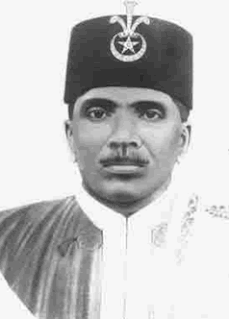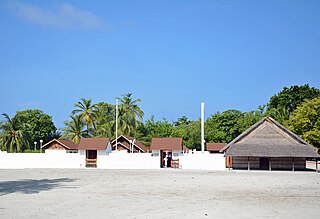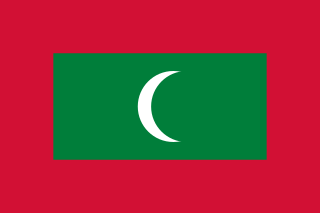This page is based on this
Wikipedia article Text is available under the
CC BY-SA 4.0 license; additional terms may apply.
Images, videos and audio are available under their respective licenses.

The history of the Maldives is intertwined with the history of the broader Indian subcontinent and the surrounding regions, comprising the areas of South Asia and Indian Ocean; and the modern nation consisting of 28 natural atolls, comprising 1194 islands. Historically, the Maldives had a strategic importance because of its location on the major marine routes of the Indian Ocean. The Maldives' nearest neighbours are Sri Lanka and India, both of which have had cultural and economic ties with Maldives for centuries. The Maldives provided the main source of cowrie shells, then used as a currency throughout Asia and parts of the East African coast. Most probably Maldives were influenced by Kalingas of ancient India who were earliest sea traders to Sri Lanka and Maldives from India and were responsible for the spread of Buddhism. Hence ancient Hindu culture has an indelible impact on Maldives' local culture.

The Maldivian rufiyaa is the currency of the Maldives. The issuance of the currency is controlled by the Maldives Monetary Authority (MMA). The most commonly used symbols for the rufiyaa are MRF and Rf. The ISO 4217 code for Maldivian rufiyaa is MVR. The rufiyaa is subdivided into 100 laari.
as-Sulṭaan al-Ghaazee Muhamadhu Thakurufaanu al-A'uẓam or Al-Sultan Ghazi Muhammad Bodu Thakurufaanu ruled over the Maldive Islands from 1573 to 1585 AD. He was a captain, environmentalist and a military strategist. He is considered as the national hero of the Maldives for driving out the Portuguese who ruled over the Maldives from 1558-1573 after killing Sultan Ali VI in Malé. His victory is commemorated in the Maldives as Qaumee Dhuvas or National Day. He was also the first Maldivian king to form the 'Lashkaru ..

Al Ameer Mohamed Ameen Dhoshimeynaa Kilegefaanu, popularly known as Mohamed Ameen Didi was a Maldivian political figure. He served as the first president of the Maldives and as the head of government between January 1, 1953, and August 21, 1953. Ameen Didi was also the principal of Majeediyya School from 1946 to 1953. Amin Didi had one daughter, Ameena Ameen. His grandson Ameen Faisal was the former Minister of Defence and National Security of Maldives. His other grandchildren are Ibrahim Faisal, Farahanaz Faisal and Aishath Shuweykar.

Abdul Majeed served as Sultan of the Maldives from 1944 to 1952. At the time, the Maldives were a British protectorate. Didi is recognized a reformer and has been described as "the father of the modern Maldives".

Sultan Muhammad Shamsuddeen Iskander III, CMG,, son of Ibrahim Nooraddeen and Kakaage Don Goma, was the Sultan of the Maldives first from 7 May 1893 and then again from 1902.

Sultan Sir Hassan Nooraddeen Iskandar II, KCMG was Sultan of the Maldives from 1935 to 1943, a son of Sultan Muhammed Mueenudheen Kalhu Bandaarain. Sultan Nooraddeen was born on 21 April 1887.

Utheemu is one of the inhabited islands of Haa Alif Atoll administrative division and geographically part of Thiladhummathi Atoll in the north of the Maldives. It is an island-level administrative constituency governed by the Utheemu Island Council.

Dhovemi Kalaminja Siri Thiribuvana-aadiththa Maha Radun or Donei Kalaminjaa was the second king of the Maldives from 1141 to 1166 or 1176 according to the Raadhavalhi and the Loamaafaanu copper plate writings. The Taarikh chronicles. however calls this king Sultan Muhammad ibn Abdullah which is probably the Muslim name of the king after his conversion to Islam in the 12th year of his reign. Later on the title of Dharumavantha (Dharumas) Rasgefaanu or 'the benevolent king' was bestowed upon him. He is also known as the first ruler of the Theemuge Dynastry. This name was derived from his house's name, Theemuge, some sourced refer to the royal house as the Maalei Dharikolhu. Though it was being called Theemuge Darikolhu they were descendents of the Buddhist Kings of the Lunar Dynastry or Soma Vansa.
Al-Sultan Salis Kalaminjaa Siri Meesuvara Mahaa Radun was the Sultan of Maldives from 1293 to 1302. He succeeded to the throne after the death of his father Sultan Yoosuf I, by becoming the 15th sultan to ascend the throne of Maldives from the Lunar dynasty.
Al-Sultan Abul Fath Jalaaluddin Omar Veeru Siri Abaarana Mahaa Radun was the Sultan of the Maldives from 1306 to 1341. He was the son of Sultan Salis. Sultan Omar I ruled the country for 35 years until his death on 1341. He had a son named Ahmed Shihaabuddheen and two daughters Khadhijah and Raadhafathi, all of whom later became rulers of the Maldives. He was succeeded by his son Ahmed Shihaabuddheen.
Al-Sultana Khadeejah Sri Raadha Abaarana Mahaa Rehendhi or more famously known as just Rehendhi Khadeejah meaning, Queen Khadeejah, was the Sultana of the Maldives from 1347 to 1380. She was one of the earliest female rulers in a Muslim nation and one of the few female rulers in the recorded history of Maldives.
Khadeeja was the eldest daughter of Omar I of the Maldives. After the death of her father Sultan Omar in 1341, his son Ahmed Shihabuddine ascended the throne as Ahmed Shihabuddine of the Maldives. Khadija had her brother, the Sultan Ahmed Shihabuddine assassinated and took the throne for herself in 1347, becoming the first female ruler of Theemuge Dynasty.
Sultan Hassan Al-Hilaaly I, Sri bavana Mahaa radhun was the first sultan to ascend the throne of Maldives from the Hilaaly dynasty by abolishing the dynasty which had ruled the Maldives for more than two centuries. He ascended the throne of The Maldives in 1388.
Sultan Ibraahim, Sri dhanmaru Veeru Mahaa radhun was the sultan of The Maldives from 1398 to 1398 and from 1412 to 1420. He was the eldest son of Sultan Hassan I of the Maldives. He ruled the country for four months and abdicated in favour for his uncle Hussain.
Sultan Hussain Al-Hilaaly I Sri loka veeru Mahaa radhun was the sultan of Maldives from 1398 to 1409. He was the son of Hilaaly Kalo and Golhaa vehi kanbulo and also a brother of Sultan Hassan I. He ruled the country for 10 years until his death on 1409.
Sultan Haji Hassan III Sri Dhaadha Veeru Mahaa Radhun was the sultan of Maldives from 1443 to 1467. He ascended the throne after the death of his father, Sultan Abookuru I. In his 25th year of reign he chose to pay a visit to Mecca for Hajj and he made his young son as the regent while he was away. While he was in Mecca he was deposed by Sayyidh Muhammad.
A constitutional referendum was held in the Maldives on 17 and 18 April 1952. The new constitution would convert the country from a monarchy to a republic.
Sultan Ibrahim Iskandhar Sri kularanmeeba Kathiri Bavana Mahaa Radun was the sultan of Maldives from 1648 to 1687. He was the son of HH Sultan Muhammad Imaduddin I and Kabaa Aisha. Iskandar ascended to the throne of Maldives at age 18, after the death of his father. During his reign, he rebuilt the Malé Hukuru Miskiy in Malé and began educating his people by teaching the Qur'an. Iskandar died in 1687 after ruling nearly for 40 years. He was succeeded by his son Kuda Muhammad under the regency of his consort Mariyam Kaba'afa'anu Rani Kilege.
Sultan Hassan V Sri raadha Aanandha Maha Radhun was the sultan of the sultanate of Maldives. He ascended to the lion throne of Maldives after the death of his father, Sultan Omar of the Maldives in 1484. His rule was short and ended upon his death in 1485.









